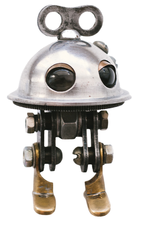GoPiGo3 robot vehicle with a Rasp Pi core
Go Pi Go

© Lead Image © Pavel Romanchenko, 123RF.com
The GoPiGo3 kit provides components and software for a small robot car with a Raspberry Pi brain.
The easiest way to learn programming is hands on. The GoPiGo3 robot kit [1], based on a Raspberry Pi, supports programming with the Bloxter graphical programming language, up to and including the development of complex applications with Python, Node.js, or C/C++.
The GoPiGo3 design makes a solid, robust impression (Figure 1). The basic frame comprises two Plexiglas plates screwed together with threaded bolts. The direct-drive motors are mounted on stable metal brackets. With a little skill, assembling the kit takes less than an hour. The manufacturer provides detailed instructions on their homepage [2] to make it easy to assemble the robots.
 Figure 1: The fully built GoPiGo3 offers everything a robot car needs. With optional accessories, you can add sensors and actuators to the structure as desired.
Figure 1: The fully built GoPiGo3 offers everything a robot car needs. With optional accessories, you can add sensors and actuators to the structure as desired.
[...]
Buy this article as PDF
(incl. VAT)
Buy Linux Magazine
Subscribe to our Linux Newsletters
Find Linux and Open Source Jobs
Subscribe to our ADMIN Newsletters
Support Our Work
Linux Magazine content is made possible with support from readers like you. Please consider contributing when you’ve found an article to be beneficial.

News
-
Mozilla Plans to AI-ify Firefox
With a new CEO in control, Mozilla is doubling down on a strategy of trust, all the while leaning into AI.
-
Gnome Says No to AI-Generated Extensions
If you're a developer wanting to create a new Gnome extension, you'd best set aside that AI code generator, because the extension team will have none of that.
-
Parrot OS Switches to KDE Plasma Desktop
Yet another distro is making the move to the KDE Plasma desktop.
-
TUXEDO Announces Gemini 17
TUXEDO Computers has released the fourth generation of its Gemini laptop with plenty of updates.
-
Two New Distros Adopt Enlightenment
MX Moksha and AV Linux 25 join ranks with Bodhi Linux and embrace the Enlightenment desktop.
-
Solus Linux 4.8 Removes Python 2
Solus Linux 4.8 has been released with the latest Linux kernel, updated desktops, and a key removal.
-
Zorin OS 18 Hits over a Million Downloads
If you doubt Linux isn't gaining popularity, you only have to look at Zorin OS's download numbers.
-
TUXEDO Computers Scraps Snapdragon X1E-Based Laptop
Due to issues with a Snapdragon CPU, TUXEDO Computers has cancelled its plans to release a laptop based on this elite hardware.
-
Debian Unleashes Debian Libre Live
Debian Libre Live keeps your machine free of proprietary software.
-
Valve Announces Pending Release of Steam Machine
Shout it to the heavens: Steam Machine, powered by Linux, is set to arrive in 2026.

